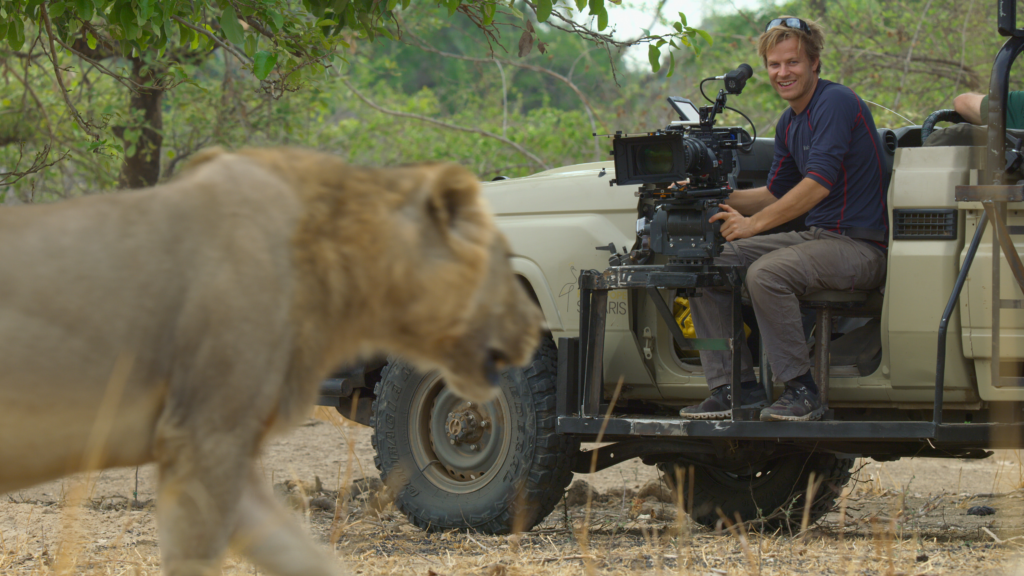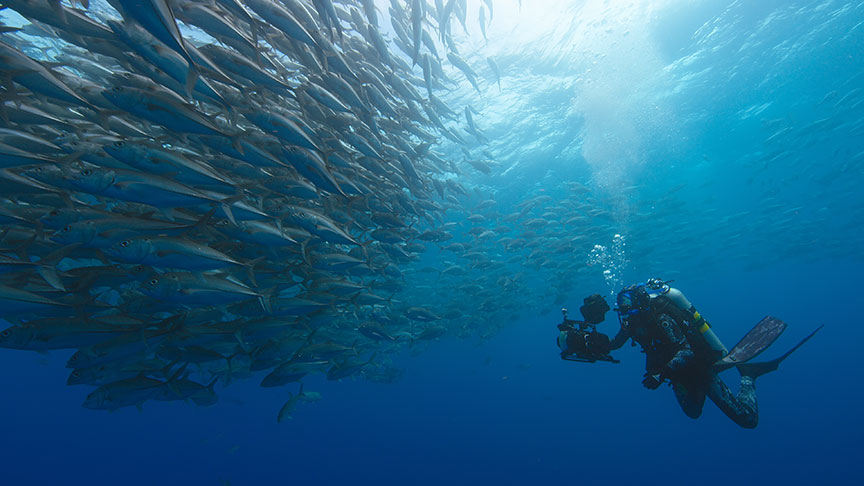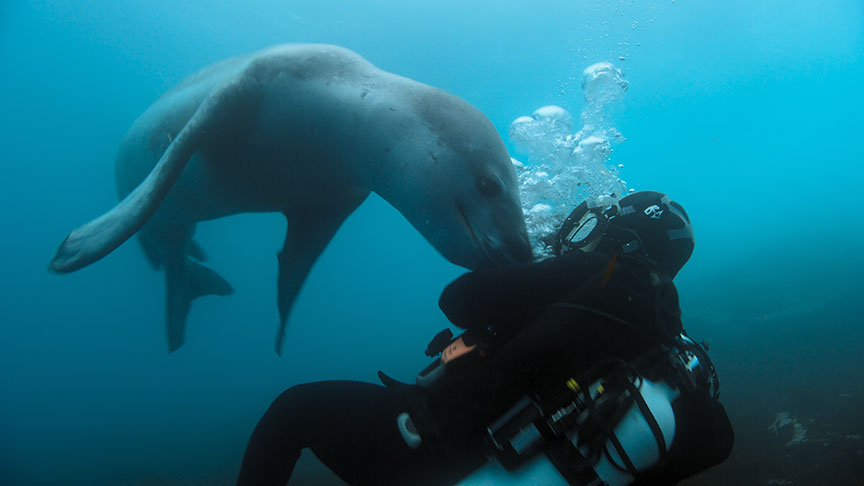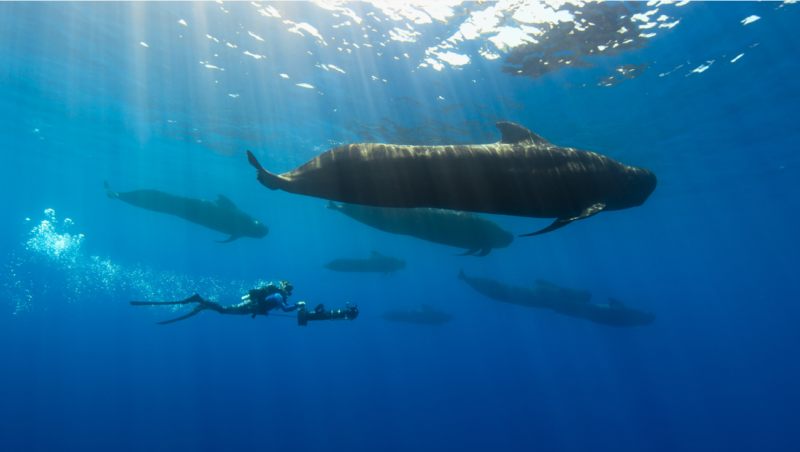It’s not every day we see a young explorer come up through the ranks and jump on challenges only tackled by the most seasoned veterans. But Bertie Gregory isn’t your average explorer.
At the ripe young age of 28, Gregory has already seen the world. He’s traversed the Arctic Sea, swam with massive whales and filmed bears up close. He’s the real deal.
Gregory entered the wildlife photography world full-time at age 20.
“Since I was knee high to a grasshopper I have been totally obsessed with the natural world,” said Gregory. “I quickly realized that taking pictures of what I was saw was not only a great way to explain where I run off to, but also a great way to get other people excited about what I was excited about.”
By 16 years old, he had won the chance to shoot alongside the UK’s top 20 wildlife photographers and was later named Youth Outdoor Photographer of the Year.
Gregory then attended the University of Bristol where he earned a degree in zoology. The next day, he boarded a plane to South Africa with wildlife photojournalist Steve Winter on an assignment from National Geographic Magazine.
“Following this baptism of fire, the project evolved into a television program,” said Gregory. “My task was to film Steve as he attempted to photograph the urban leopards of Mumbai and the jungle leopards of Sri Lanka.”

A few short years later, with the help of some grant funding, Gregory pulled his first solo assignment from National Geographic. His mission was to film the elusive coastal wolf on the west coast of Vancouver Island, Canada. The project released as a 16-part series in August 2016, called Wild Life with Bertie Gregory.
Later that same year, he joined the prestigious BBC Natural History Unit where he worked on the David Attenborough series Seven Worlds, One Planet. The work earned him a BAFTA award for cinematography.
Now, Bertie Gregory finds himself in new territory with his own show called Epic Adventures with Bertie Gregory. The show, which premieres in Disney+ late this summer and is already signed on for a second season, will feature Gregory and a team traveling the world in search of elusive creatures and showing them in their natural habitats.
In the new show, he will come face-to-face (quite literally) with massive fin whales, sharks, lions and even an amazing touch-and-go encounter with a leopard seal.
We recently had the chance to screen an episode and then chat with Gregory about his adventures. Enjoy the interview below.
Innovation & Tech Today: Such a small number of people have ever seen Antarctica and that part of the world. What’s it like going there?
Bertie Gregory: Yeah, I mean to get there, yeah, we decided that we wanted to go really small. Often when you go to Antarctica filming, the crossing through Drake Passage is very rough. But then, once you’re there, it’s actually kind of sheltered because there’s lots of hidden calm bays. But the whale gathering we were trying to film, because it happens outside of those bays, it happens in the rough bit of ocean. You kind of need to just be there for a really long time, so that eventually it’s going to be calm. And we had about five weeks on the boat and we had six filming days.
I&T Today: Wow.
BG: Yeah. And so for that reason, unless you’ve got a ridiculous budget, being in a little sailboat is the way forwards, because it’s much more cost effective and it just means you are still sort of maneuverable. We could launch divers and fly drones — all that stuff. So, I guess in answer to your question, the main challenge is not going crazy because a 75-foot-boat is not very big for nine people for that long. It was pretty smelly by the end.
I&T Today: Oh, I bet it was. And it has to just beat you to death out there. I mean, the seas looked rough.
BG: Yeah. Yeah. It’s well, I mean the Drake passage where we were is sort of famed as being the roughest bit of ocean on the planet. And it definitely lived up to its name while we were there. We had these satellite weather forecasts and on the satellite weather, they’re like color coded just like a normal weather forecast for the wind speed. And top wind speeds were purple in color. And the Captain, Ben, used to sort of huddle us around in the evening to say, okay, tomorrow is going to be a BPM, which is a big purple monster, which is just this big purple blob on the map, which meant we were just going to get hammered, and yeah. We didn’t do a whole lot of filming, to be honest. We did a lot of sitting on anchor and sort of holding on for dear life.

I&T Today: One of the things I noticed about your show is that you seem super happy. Like you’re enjoying yourself. And I wondered, is it difficult to keep that positive attitude when the world is kind of trying to kill you down there?
BG: Yeah. I guess the there’s sort of a sliding scale between exciting and terrifying, right?
It is not really one or the other. So a lot of the time it’s sort of giddy excited nerves, I guess. I mean, that said, the best bit to me about filming is, aside from the amazing animal encounters, which are always great, just like the teamwork is always brilliant. And I pride myself on putting together teams of the best people in the world, because that’s how you get stuff done. You find the best people, get them together and go for it.
And so whilst it was a very sort of hostile environment, we had basically the best boat captain for that place. I was diving with one of the best underwater camera people in the world, Dan Beachum. We had a guy called Hector who was filming the gyro stabilized stuff. So, we just had the best people in all the, I guess, disciplines. So, although it is a very hostile environment, it’s manageable because you’re surrounded by such talented people.
I&T Today: Is it, being out in that little rubber boat around all those whales, I mean, even with the big ship. Is one of those whales capable of capsizing your ship?
BG: I mean, the big boat, probably not really. The little boat, 100% possible. That said, these whales are so aware of their surroundings. I mean, they’re hunting a little crustacean that’s an inch long. So they’ve got their senses dialed.
That said, I think the, and obviously us in the water as well, that’s obviously even more dangerous. I should say, potentially dangerous. And we weren’t worried about whales sort of ramming into us on purpose. And we weren’t worried about, I guess, getting on collision courses or whatever, because one, we don’t want to disturb the whales, but two there’s really strict permitting down there. So, we’d always sort of get ourselves into a position, not ahead of the whales because you never want to cut them off, but just sort of vaguely near.
Then the action is, there’s 300 whales all going nuts in all different directions and they sort of are on a couple football field sized area, just moving around and that area shifts as the krill moves. So what we were most concerned about was a lot of whales sort of all converging on a really concentrated area of krill and then them just avoiding each other and we are tiny and just sort of accidentally getting bumped.
Yeah, I guess that was a genuine risk, but we kind of thought about it and that never happened. We had some whales come really, really close. I mean, all our best shots are when the whales sort of like avoiding another whale and they sort of come over to you and you can see them going. They know exactly where you are. You can see them going, okay, you are there. I’m just going to, yeah.
I&T Today: Just making sure you don’t get whacked by a tail then accidentally would be the goal then?
BG: You got it. To be honest, genuinely the biggest danger there was getting lost when we’re in the water. When just even the tiniest bit of chop and suddenly it’s really hard to keep an arm diver. So we did cover that in the episode with Callum. He was always on the surface above us with a little flag. So, Dave and the Zodiac always knew where we were.
But we had some moments where we kind of got separated for a little bit. And I tell you, when you come up to the surface and Callum’s there and you look around and you’re like, “Callum, where’s the Zodiac?” And he’s like, “Oh, I haven’t seen it for a little while.” Suddenly like the world comes crashing down and you feel very, very tiny and very, very cold. And you’re like, okay, cool. Well, hopefully we do find that, otherwise we’re in big trouble.
I&T Today: I wondered even in a wet suit, how do you tolerate that kind of arctic water temperatures?
BG: Well, yeah, so I guess the traditional strategy in those temperatures is to use a dry suit, but because we were needing to get in and out of the water a lot, like as the whale action moves, you need to be in out, in, out. And with the leopard seal, I wanted to be able to get out really quickly, if she got unhappy.
And you’re just way faster in that the water with a wetsuit on. So yeah. As, yeah, just like any wetsuit, it lets water in and the water there’s minus one degree Celsius. I’m not sure what that is in Fahrenheit, like 34 or something. And so, yeah, you are kind of running on adrenaline. If the action’s not really good, you’ve probably got 15, 20 minutes before you start getting really cold. But it’s amazing what the human body’s capable of when you trigger your sort of caveman instincts.
I&T Today: I bet it is. Well, I noticed like the leopard seal didn’t even seem uncomfortable around you. Matter of fact, it just came over to check things out. I did think she was going to eat you once, but she just kind of started sniffing around.
BG: Yeah. So before that, I’d never been in the water with a leopard seal before, but I’ve been in the water with lots of other species of seals and sea lions and yeah. I mean, they totally are aware immediately that they are so much more capable in the water than you are. And so they’re certainly at ease. And I guess the thing that makes it look scary and it’s certainly intimidating, is that they put your body parts and your camera in their mouths and that’s because, yeah, if you or I encounter a new object, we just use our hands. Well, they don’t have hands. They got flippers so, they mouth things. So it’s not like an aggressive, “I want to eat you,” bite. It’s a “what are you?”
That said, she was getting more and more confident as you, like in that scene, you see how her behavior changes?

I&T Today: Tell me about your career path. What got you to where you are right now?
BG: So ever since I was really young, I’ve been always encouraged by my family to be in the sea. My mom and dad, my three brothers, they’re all obsessed with being in the ocean and water sports. So from a really young age, I was surfing on the Cornish coast in England. I think when you spend that amount of time, just sort of outside on the ocean, you gain an appreciation for, I guess, the natural world. That sort of led me to get interested in wildlife.
Then during my teenage years, as I got more and more obsessed with wildlife, I realized that if I took pictures of what I was sort of sneaking off and missing parties and sports practice to go do, if I took pictures of what I was doing, it was one, a great way to sort of channel my obsession with these animals. But more importantly, at the time, it was a good way to explain to other people like where I’d been.
So I guess that was sort of the early beginnings of it. Then I won a few young wildlife photography competitions and through a long series of events got to meet one of the National Geographic magazine photographers, a guy called Steve Winter. And he sort of offered me my Willy Wonka golden ticket, I guess.
Right place, right time, said the right thing. He said, “Yeah, do you want to come be my assistant?” So, I assisted him for just over two years doing assignments on leopards and jaguars for National Geographic. And that was sort of my foot in the door, there back in, yeah, 2014.
I&T Today: Well, Bertie, what’s next for you?
BG: Well, we’ve got a second season of this show commissioned ahead of the launch of season one. So that’s very exciting. We’ve shot two episodes and we’ve got four to go and yeah, we’re going all over the place. Season one, it’s going to be awesome. Really excited. But season two, we’re trying to dial it up as you always do. So, yeah. The adventures are hopefully getting even more epic.











